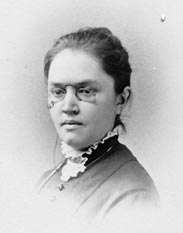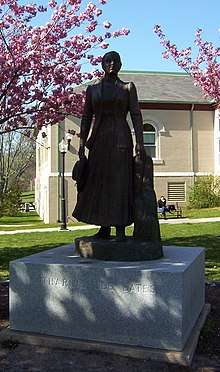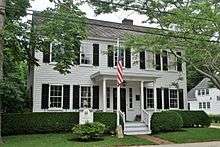Katharine Lee Bates
| Katharine Lee Bates | |
|---|---|
 | |
| Born |
August 12, 1859 Falmouth, Massachusetts, United States |
| Died |
March 28, 1929 (aged 69) Wellesley, Massachusetts, United States |
| Occupation | Author, Poet, Educator |
| Nationality | American |
| Genre | Poetry |
| Notable works |
"America the Beautiful" Goody Santa Claus on a Sleigh Ride |
Katharine Lee Bates (August 12, 1859 – March 28, 1929) was an American writer, poet, professor, and social activist. Although she was a renowned author and professor during her lifetime, today she is primarily remembered as the author of the words to the anthem "America the Beautiful". For 25 years, she lived with her long-time friend and companion, Katharine Coman.
Life and career
Bates was born in Falmouth, Massachusetts, the daughter of Congregational pastor William Bates and Cornelia Frances Lee. Her father died a few weeks after she was born, and she was primarily raised by her mother and a literary aunt, both of whom had graduated from the all-women's Mount Holyoke Seminary.[1][2] She graduated from Needham High School in 1872, from Newton High School in 1875,[3] and from Wellesley College with a B.A. in 1880. Wellesley College was a women's college, and Bates entered as the second class in 1876.[2] She taught at Natick High School during 1880–81 and at Dana Hall School from 1885 until 1889. Taking advantage of the new educational opportunities available to women after the Civil War,[1] and using prize money won for her novel for young adults,[2] she studied at Oxford University during 1890–91.[4] Bates then returned to Wellesley first as an instructor, then an associate professor in 1893. She earned her M.A. and became full professor of English literature.[1]
Bates helped to found the new field of the study of American literature by creating a new college course on the genre and by writing one of the first textbooks on American literature. She was the first woman to write such a book.[2] Ponder, a biographer, credits Bates with "blaz[ing] the trail for today's American literature courses."[2]:II
While working at Wellesley, she was elected a member of the newly formed Pi Gamma Mu honor society for the social sciences because of her interest in history and politics. She officially retired from Wellesley in 1925 at the age of 66.[1]:274 After her retirement, Bates continued to write and to publish poetry, and was in great demand as a writer and speaker.[1]:274

Bates was a prolific author of many volumes of poetry, travel books, essays, children's books and books for young adults.[1][2] Her pioneering text, American Literature,[2] is still in print. Her prize-winning novel, Rose and Thorn, written for young adults, incorporated poor and working class women as characters to teach readers about social reform.[2][1] She popularized the concept of Mrs. Claus in her poem Goody Santa Claus on a Sleigh Ride from the collection Sunshine and other Verses for Children (1889). The Mrs. Claus character is the chief organizer of Christmas Eve.[1] Near the end of the war between Spain and America, she was a war correspondent for The New York Times, and worked to reduce the contemporaneous negative stereotypes about Spaniards.[2] She contributed regularly to periodicals, sometimes under the pseudonym James Lincoln, including Atlantic Monthly, The Congregationalist, Boston Evening Transcript, Christian Century, Contemporary Verse, Lippincott's, and Delineator.[5] At Wellesley, she was credited with mentoring dozens of young poets.[1] During her lifetime, she was considered to be "an esteemed teacher, a prolific poet, and a widely published author."[6]:60–62
In addition to being a popular college professor, mentor, and writer, Bates was a social activist interested in the struggles of women, workers, people of color, tenement residents, immigrants, and poor people.[1][2] She co-founded Denison House, a college women's settlement house, with other women friends and colleagues in Boston in 1892[1]:110 and wrote and talked extensively about the need for social reform.[2] Bates was an avid advocate for the global peace movement that emerged after WWI and was especially active in attempts to establish the League of Nations.[1][2] A lifelong, active Republican, Bates broke with the party to endorse Democratic presidential candidate John W. Davis in 1924 because of Republican opposition to American participation in the League of Nations. She said: "Though born and bred in the Republican camp, I cannot bear their betrayal of Mr. Wilson and their rejection of the League of Nations, our one hope of peace on earth."[7] Thinking of herself as a "global citizen," Bates decried the American policy of isolationism.[1]:262
In the biography written by Melinda M. Ponder, Bates is described as an independent-minded social activist who set an example for women's intellectualism and independence in the late 1800s.[1] Bates was courted by several young men when she was in the 20s and early 30s, but she never married.[1] Ponder uses Bates' diaries and surviving letters to document that Bates was likely to have been in love with two of these men, e.g. Oscar William Morris, who she met while at Oxford; and Theophilus Huntington Root, who was the brother of one of her Wellesley classmates.[1] Faderman disputes this interpretation of Bates' diaries, claiming that Bates had preferred women as companions since she was a young girl.[8]:192 What is well documented is the fact that Bates lived and traveled with her long time companion, Katharine Coman, for 25 years.[1][6][9] In 1910, when a colleague described "free-flying spinsters" as "fringe on the garment of life", Bates answered: "I always thought the fringe had the best of it. I don't think I mind not being woven in."[10] At the time, 43% of Wellesley College graduates never married.[11]:190
.jpg)
Bates died in Wellesley, Massachusetts, on September 28, 1929 in the same room as her companion Coman had in 1915.[6] She died while listening to a friend read poetry to her.[6] She is buried in Oak Grove Cemetery at Falmouth.[12] Most of her papers are housed at the Wellesley College Archives and include "diaries, correspondences, musical scores, publications, scrapbooks, manuscripts, reports, memorials and tributes, memorabilia; concerning "America the Beautiful" and other writings of Katharine Lee Bates, her travels, and her life at Wellesley, Falmouth, Mass."[13]:1
Relationship with Katharine Coman
Bates lived in Wellesley with her long-time friend and companion, Katharine Coman,[6] in a house the two built and named "The Scarab," in remembrance of a trip they made together to Egypt.[6]:63 Coman was also a professor at Wellesley College.[1] Historians D'Emilio and Freedman document that unmarried middle class educated women during the era commonly formed such pair bonds and were "passionately attached to one another and committed to a lifetime together."[11]:191 Historian Lillian Faderman also writes about romantic friendships among women, and specifically lists Bates and Coman as among the many women academics who formed pair bonds.[14]:450 Called Boston marriages in the late 1800s, these relationships were characterized as a "long-term monogamous relationship between two otherwise unmarried women."[14]:190 These relationships may or may not have had a sexual component.[11]:192[14]:190 Faderman documents that there were so many female pairs among Wellesley faculty that the relationships were often referred to as Wellesley marriages.[8]:192 Faderman also notes that in the late 19th century, of the 53 women faculty members at Wellesley, only one of them was conventionally married to a man.[8]:192
Coman was a history and political economy professor, and founder of the Wellesley College Department of Economics. During her lifetime, Coman was nearly as well known as Bates.[6]:61 Coman and Bates met at Wellesley in 1890[6] when the president of Wellesley College, Alice Freeman Palmer,[2] determined to hire many new women faculty to teach and to work at the college.[1] The pair lived and traveled together for twenty-five years until Coman's death from breast cancer in 1915.[6] In the days after Coman's death, Bates wrote a memorial to Coman, which is thought to be the first American narrative about breast cancer.[6] Bates intended that the manuscript be privately circulated among the women's close circle of friends and family, writing on the title page: "For Katharine Coman's family and innermost circle of friends: Not for print nor in any way for general circulation."[6]:63[13]
In 1922, Bates published Yellow Clover: A Book of Remembrance, a collection of poems written "to or about my Friend" Katharine Coman, some of which had been published in Coman's lifetime.[15]
In her 1979 article, Schwarz describes the couple as intimate lesbian partners,[9] citing as an example Bates' 1891 letter to Coman: "It was never very possible to leave Wellesley [for good], because so many love-anchors held me there, and it seemed least of all possible when I had just found the long-desired way to your dearest heart... Of course I want to come to you, very much as I want to come to Heaven."[16] Faderman also claims that the relationship between Bates and Coman was a "lesbian arrangement," including them among the other women faculty at Wellesley who paired off with each other.[8]:196 Other scholars contest the use of the term lesbian to describe what was characterized at the time as a "Boston marriage". Writes one: "We cannot say with certainty what sexual connotations these relationships conveyed. We do know that these relationships were deeply intellectual; they fostered verbal and physical expressions of love."[17]
At some point, Bates destroyed the majority of the letters the two had written to each other.[1]:104 One of the few to survive was written by Bates to Coman in 1893, just before she left Oxford to return to Wellesley: "You are always in my heart and in my longings... It was the living away from you that made, at first, the prospect of leaving Wellesley so heartachy ... and it seemed least of all possible when I had just found the long-desire way to your dearest heart."[1]:104 An additional issue is that Dorothy Burgess, who was Bates' niece and author of a 1952 biography of Bates, "expurgated her discussion of the relationship between Bates and Coman in [her book] Dream and Deed," including deleting some words and phrases and adding others.[8]:383–84
"America the Beautiful"
.jpg)
The first draft of "America the Beautiful" was hastily jotted down in a notebook during the summer of 1893, which Bates spent teaching English at Colorado College in Colorado Springs, Colorado. Later she remembered:
One day some of the other teachers and I decided to go on a trip to 14,000-foot Pikes Peak. We hired a prairie wagon. Near the top we had to leave the wagon and go the rest of the way on mules. I was very tired. But when I saw the view, I felt great joy. All the wonder of America seemed displayed there, with the sea-like expanse.
Ponder explains how Bates had personally experienced sexist prejudice and discrimination, had witnessed the ravages of the industrial revolution in both America and Britain, had seen first hand urban poverty and misery, and that she keenly wished for equality. Ponder claims that it was this desire for an inclusive American "brotherhood" that inspired the poem, which was written during the severe economic depression of 1893.[1] The words to her famous poem first appeared in print in The Congregationalist, a weekly journal, for Independence Day, 1895. The poem reached a wider audience when her revised version was printed in the Boston Evening Transcript on November 19, 1904. Her final expanded version was written in 1913. When a version appeared in her collection America the Beautiful, and Other Poems (1912), a reviewer in the New York Times wrote: "we intend no derogation to Miss Katharine Lee Bates when we say that she is a good minor poet."[18] On November 11, 1918, the 26th Infantry Division of the US Army (colloquially known as the Yankee Division) sang "America the Beautiful" upon hearing the announcement of the Armistice.[1]:xvii
The hymn has been sung to several tunes, but the familiar one is by Samuel A. Ward (1847–1903), written for his hymn "Materna" (1882).
Honors

The Bates family home on Falmouth's Main Street is preserved by the Falmouth Historical Society. There is also a street named in her honor, "Katharine Lee Bates Road" in Falmouth. The "Shining Sea Bike Trail", named in honor of Bates, extends 11 miles from North Falmouth to Woods Hole, passing just a block from the Bates home.[19] A plaque marks the site of the home where she lived as an adult on Centre Street in Newton, Massachusetts. The historic home and birthplace of Bates in Falmouth, was sold to Ruth P. Clark in November 2013 for $1,200,000.[20]
The Katharine Lee Bates Elementary School on Elmwood Road in Wellesley, Massachusetts, and the Katharine Lee Bates Elementary School, founded in 1957 in Colorado Springs, Colorado,[21] and Bates Hall dormitory at Wellesley College are named for her. The Katharine Lee Bates Professorship was established at Wellesley shortly after her death.[22]
Bates was inducted into the Songwriters Hall of Fame in 1970.[23]
Collections of Bates's manuscripts are housed at the Arthur and Elizabeth Schlesinger Library on the History of Women in America, Radcliffe College; Falmouth Historical Society; Houghton Library, Harvard University; Wellesley College Archives.[5]
In 2012, she was named by Equality Forum as one of their 31 Icons of the 2015 LGBT History Month.[24]
Works
Author
- The College Beautiful, and Other Poems, Houghton (Cambridge, Massachusetts), 1887.
- Rose and Thorn, Congregational Sunday-School and Publishing Society (Boston, MA), 1889.
- Hermit Island, Lothrop (Boston, MA), 1890.
- Sunshine, and Other Verses for Children, Wellesley Alumnae (Boston, MA), 1890.
- The English Religious Drama, Macmillan (New York, NY), 1893, reprinted, Kennikat Press (Port Washington, NY), 1966.
- American Literature, Chautauqua Press (New York, NY), 1897.
- Spanish Highways and Byways, Macmillan (New York, NY), 1900.
- (As James Lincoln) Relishes of Rhyme, Richard G. Badger (Boston,MA), 1903.
- From Gretna Green to Land's End: A Literary Journey in England, photographs by Katharine Coman, Crowell (New York, NY), 1907.
- The Story of Chaucer's Canterbury Pilgrims, Rand, McNally (Chicago, IL), 1909.
- America the Beautiful, and Other Poems, Crowell (New York, NY), 1911.
- In Sunny Spain with Pilarica and Rafael, Dutton (New York, NY), 1913.
- Chaucer's Canterbury Pilgrims, Retold by Katharine Lee Bates, illustrated by Angus MacDonall, color plates by Milo Winter, Rand, McNally (Chicago, IL), 1914.
- Fairy Gold, Dutton, (New York, NY), 1916.
- The Retinue, and Other Poems, Dutton (New York, NY), 1918.
- Sigurd Our Golden Collie, and Other Comrades of the Road, Dutton (New York, NY), 1919.
- Yellow Clover, A Book of Remembrance, Dutton (New York, NY), 1922.
- Little Robin Stay-Behind, and Other Plays in Verse for Children, Woman's Press (New York, NY), 1923.
- The Pilgrim Ship, Woman's Press (New York, NY), 1926.
- America the Dream, Crowell (New York, NY), 1930.
- An Autobiography, in Brief, of Katharine Lee Bates, Enterprise Press (Falmouth, MA), 1930.
- Selected Poems of Katharine Lee Bates, edited by Marion Pelton Guild, Houghton Mifflin (Boston, MA), 1930.
Compiler
- Browning Studies: Bibliography, Robinson (Boston, MA), 1896.
- English Drama: A Working Basis, Robinson(Boston, MA), 1896, enlarged as Shakespeare: Selective Bibliography and Biographical Notes, compiled by Bates and Lilla Weed, Wellesley College (Wellesley, MA), 1913. Compiled with Lydia Boker Godfrey.
- English History Told by English Poets, Macmillan (New York, NY), 1902. Compiled with Katharine Coman.
Contributor
- Historic Towns of New England, edited by Lyman P. Powell, Putnam (New York, NY), 1898.
Editor
- The Wedding Day Book, Lothrop (Boston, MA), 1882, published as The Wedding-Day Book, with the Congratulations of the Poets, Lothrop (Boston, MA), 1895.
- Coleridge's The Rime of the Ancient Mariner|Ancient Mariner, Leach, Shewell & Sanborn (Boston, MA), 1889.
- Ballad Book, Leach, Shewell & Sanborn (Boston, MA), 1890, reprinted, Books for Libraries Press (Freeport, NY), 1969.
- Shakespeare's Comedy of The Merchant of Venice, Leach, Shewell & Sanborn (Boston, MA), 1894.
- Shakespeare's Comedy of A Midsummer Night's Dream, Leach, Shewell & Sanborn (Boston, MA), 1895.
- Shakespeare's Comedy of As You Like It, Leach, Shewell & Sanborn (Boston, MA), 1896.
- Stories from the Chap-Book, Stone (Chicago, IL), 1896.
- Keats's The Eve of St. Agnes, and Other Poems, Silver, Burdett, (New York, NY), 1902.
- The Works of Nathaniel Hawthorne, fourteen volumes, Crowell (New York, NY), 1902.
- Hamilton Wright Mabie, Norse Stories Retold from the Eddas, Rand, McNally, Chicago, 1902.
- The Poems of Alice and Phoebe Cary, Crowell (New York, NY), 1903.
- John Ruskin, The King of the Golden River; or, the Black Brothers: A Legend of Stiria, illustrated by John C. Johansen, Rand, McNally (Chicago, IL), 1903.
- Tennyson's The Princess, American Book Co. (New York, NY), 1904.
- Tennyson's Gareth and Lynette, Lancelot and Elaine, The Passing of Arthur, Sibley (Boston, MA), 1905.
- The New Irish Drama, Drama League of America (Chicago, IL), 1911.
- Thomas Heywood, A Woman Killed with Kindness, and the Faire Maide of the West, Heath (Boston, MA), 1917.
- Once Upon a Time; A Book of Old-Time Fairy Tales, illustrated by Margaret Evans Price, Rand, McNally (Chicago, IL), 1921.
- Tom Thumb and Other Old-Time Fairy Tales, illustrated by Price, Rand, McNally (Chicago, IL), 1926.
- Jack the Giant-Killer, Rand, McNally (Chicago, IL), 1937.
- Jack and the Beanstalk; also Toads and Diamonds, Rand, McNally (Chicago, IL), 1937.
Introduction
- Nathaniel Hawthorne, Our Old Home: A Series of English Sketches, Crowell (New York, NY), 1906.
- Helen Sanborn, Anne of Brittany, Lothrop, Lee & Shepard (Boston, MA), 1917.
- Helen Corke, The World's Family, Oxford University Press (New York, NY), 1930.
Translator
- Gustavo Adolfo Becquer, Romantic Legends of Spain, Crowell (New York). With Cornelia Frances Bates.
See also

References
Notes
- 1 2 3 4 5 6 7 8 9 10 11 12 13 14 15 16 17 18 19 20 21 22 23 Ponder, Melinda M. (2017). Katharine Lee Bates: From Sea to Shining Sea. Chicago, IL: Windy City Publishers. ISBN 9781941478479
- 1 2 3 4 5 6 7 8 9 10 11 12 13 Ponder, Melinda M. (2016). "On the trail of Katharine Lee Bates: Talk for the Wellesley Reunion Class of 1966." https://www.wellesley.edu/sites/default/files/assets/departments/alumnae/files/women_klbates_mponder1.pdf Accessed July 5, 2018.
- ↑ http://museumsonthegreen.org/wp-content/uploads/Katharine-Lee-Bates-Manuscript-Collection.pdf
- ↑ Leonard, John William, ed. (1914), Woman's Who's Who of America: A Biographical Dictionary of Contemporary Women of the United States and Canada, 1914-1915, New York: American Commonwealth Company, p. 82
- 1 2 Contemporary Authors Online, Gale, 2009. Reproduced in Biography Resource Center. Farmington Hills, Michigan: Gale, 2009. Fee
- 1 2 3 4 5 6 7 8 9 10 11 Leopold, Ellen (2006). "My soul is among lions: Katharine Lee Bates' account of the illness and death of Katharine Coman". Frontiers: A Journal of Women Studies. 23 (1): 60–73. doi:10.1353/leg.2006.0008.
- ↑ New York Times: "Republican Women Declare for Davis," October 20, 1924, accessed January 6, 2012
- 1 2 3 4 5 Faderman, Lillian. (1999). To believe in women: What lesbians have done for America--a history. Boston, MA: Houghton Mifflin Company. ISBN 039585010
- 1 2 Schwarz, Judith (Spring 1979). ""Yellow Clover": Katharine Lee Bates and Katharine Coman". Frontiers: A Journal of Women Studies. 4 (1): 59–67. doi:10.2307/3346671. JSTOR 3346671.
Quote p. 59: Katharine Lee Bates and Katharine Coman were a devoted lesbian couple.
- ↑ Schwarz, "Yellow Clover", 65
- 1 2 3 D'Emilio, John, and Estelle Freedman. (2012). Intimate matters: A history of sexuality in America (third edition). Chicago, IL: University of Chicago Press. ISBN 9780226923802 ta
- ↑ Wilson, Scott. Resting Places: The Burial Sites of More Than 14,000 Famous Persons, 3d ed.: 2 (Kindle Locations 2892-2893). McFarland & Company, Inc., Publishers. Kindle Edition.
- 1 2 "Katharine Lee Bates". Retrieved July 5, 2018.
- 1 2 3 Faderman, Lillian. (1981.) Surpassing the Love of Men. New York: William Morrow and Company. ISBN 0688003966
- ↑ Internet Archive: Yellow Clover: A Book of Remembrance, (E.P. Dutton, 1922), quote viii, accessed January 6, 2012
- ↑ Schwarz, "Yellow Clover", 63
- ↑ Palmieri, Patricia A. (Summer 1983). "Here was fellowship: a social portrait of academic women at Wellesley College". History of Education Quarterly. 23 (2): 195–214. doi:10.2307/368159. JSTOR 368159.
Quote, pp. 205.
- ↑ New York Times: "A Good Minor Poet," March 24, 1912, accessed January 6, 2012
- ↑ "Shining Sea Bike Trail". capecodbikebook.com.
- ↑ Hufstader, Louisa. "Sold! Historic Katharine Lee Bates Home". Falmouth Patch. Retrieved 23 December 2013.
- ↑ "Katharine Lee Bates Elementary School in Colorado Springs, CO". d11.org.
- ↑ Jane Chance, Women Medievalists and the Academy (University of Wisconsin Press, 2005), 241
- ↑ Songwriters Hall of Fame: Katharine Lee Bates, accessed January 6, 2012
- ↑ "Katahrine Lee Bates biography". LGBT History Month. Retrieved 5 October 2012.
Further reading
- Dorothy Burgess, Dream and Deed: The Story of Katharine Lee Bates (Norman, Oklahoma: University of Oklahoma Press, 1952)
- "Katharine Lee Bates" in Notable American Women: The Modern Period, A Biographical Dictionary, edited by Barbara Sicherman, Carol Hurd Green with Ilene Kantrov, Harriette Walker (Cambridge: Harvard University Press, 1980)
- Almanac of Famous People, sixth edition, Gale (Detroit, MI), 1998.
- Dictionary of Literary Biography, Volume 71: American Literary Critics and Scholars, 1880–1900, Gale (Detroit, MI), 1988.
- Encyclopedia of World Biography, Volume 2, Gale (Detroit, MI), 1998.
- Gay and Lesbian Literature, St. James Press (Detroit, MI), 1998.
- Vida Dutton Scudder, On Journey, E.P. Dutton (New York, NY), 1937.
- Drury, Michael, "Why She Wrote America's Favorite Song," Reader's Digest, July 1993, pp. 90–93.
- Price, Deb. The Bellingham Herald, July 4, 1998: "Two women's love made 'America' Beautiful".
- Christian Science Monitor, July 19, 1930.
- The Dial, January 16, 1912.
- International Book Review, June 24, 1924.
- The Nation, November 30, 1918.
- New York Times, July 14, 1918; August 17, 1930.
External links
| Wikisource has original works written by or about: Katharine Lee Bates |
| Wikimedia Commons has media related to Katharine Lee Bates. |
- Lee Bates Katharine Lee Bates at the Songwriters Hall of Fame
- The Origin of American Christmas Myth and Customs
- "The Katharine Lee Bates Shrine!". Archived from the original on June 13, 2006. Retrieved 2009-02-16. (A site devoted to Miss Bates and Falmouth, Massachusetts)
- Falmouth Museums on the Green
- Works by Katharine Lee Bates at Project Gutenberg
- Works by or about Katharine Lee Bates at Internet Archive
- Works by Katharine Lee Bates at LibriVox (public domain audiobooks)

- Biography and Poetry of Bates, part of a Series poet's biographies.
- Katharine Lee Bates at Library of Congress Authorities, with 80 catalog records